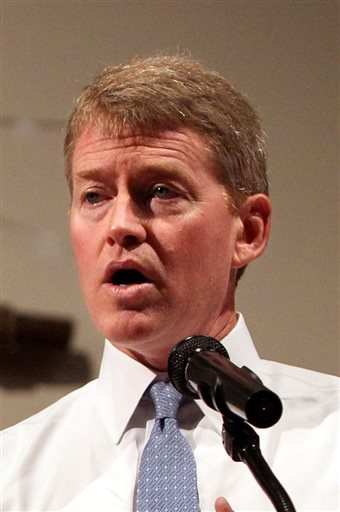 FILE – This Aug. 17, 2014 file photo shows Missouri Attorney General Chris Koster speaking in Ferguson, Mo. In a report released Monday, June 1, 2015, Koster says the state’s African-American drivers were 75 percent more likely than their white counterparts to be stopped on Missouri’s roads based on their proportionate share of the driving-age population. (AP Photo/St. Louis Post-Dispatch, Christian Gooden, file) MANDADORY CREDIT; EDWARDSVILLE INTELLIGENCER OUT; THE ALTON
FILE – This Aug. 17, 2014 file photo shows Missouri Attorney General Chris Koster speaking in Ferguson, Mo. In a report released Monday, June 1, 2015, Koster says the state’s African-American drivers were 75 percent more likely than their white counterparts to be stopped on Missouri’s roads based on their proportionate share of the driving-age population. (AP Photo/St. Louis Post-Dispatch, Christian Gooden, file) MANDADORY CREDIT; EDWARDSVILLE INTELLIGENCER OUT; THE ALTON
By JIM SUHR
The disparity in the rate at which Missouri authorities pulled over black drivers compared with whites last year surged to its highest level since the state began compiling data 15 years ago, the state’s top law enforcer said Monday.
Attorney General Chris Koster’s annual report analyzing traffic stops by race found that African-American drivers were 75 percent more likely than white motorists to be stopped on Missouri’s roads based on their proportionate share of the driving-age population. That’s nine percentage points higher than last year. In 2000, blacks were 31 percent more likely than whites to be pulled over.
The report is Missouri’s first since the racial unrest that followed the shooting death last August in Ferguson of Michael Brown, a black, unarmed 18-year-old, by a white police officer. Koster’s report shows that black drivers in the predominantly black St. Louis suburb were stopped last year at a disparity rate lower than the statewide average.
Koster cautioned that with 622 law enforcement agencies, there is no single explanation as to why the disparities exist and that the statistics don’t prove law officers are making vehicle stops based on the driver’s race. But Koster said in a statement that his office’s analysis of nearly 1.7 million 2014 traffic stops “provides law enforcement, legislators and the public a starting point as they consider improvements to process and changes to policy to address these issues.”
Law enforcement officers say racial disparities in traffic stops may appear higher in some predominantly white cities because of interstate highways or retail and tourist destinations that attract minority drivers who are not part of the local population.
The report shows that Hispanic drivers were stopped at a lower rate than white or black drivers. Law officers searched Hispanic and black drivers at a higher rate than white drivers. But of those who were searched, whites were found with contraband at a higher rate than black and Hispanic drivers.
Roughly five dozen law enforcement agencies indicated they made no traffic stops last year, Koster said.
Even though Ferguson fared better than the statewide average, that city’s policing and municipal courts were widely scrutinized after Brown’s shooting death touched off angry, sometimes violent protests. The case also led to demonstrations in other cities and spawned a national “Black Lives Matter” movement seeking changes in how police deal with minorities.
A grand jury and the Justice Department cleared the white officer in Brown’s death, but the federal agency did release a scathing report that cited racial bias and profiling in Ferguson policing and in a profit-driven municipal court system that frequently targeted blacks.
Ferguson’s police chief, municipal court judge and city manager resigned following the Justice Department’s probe.



